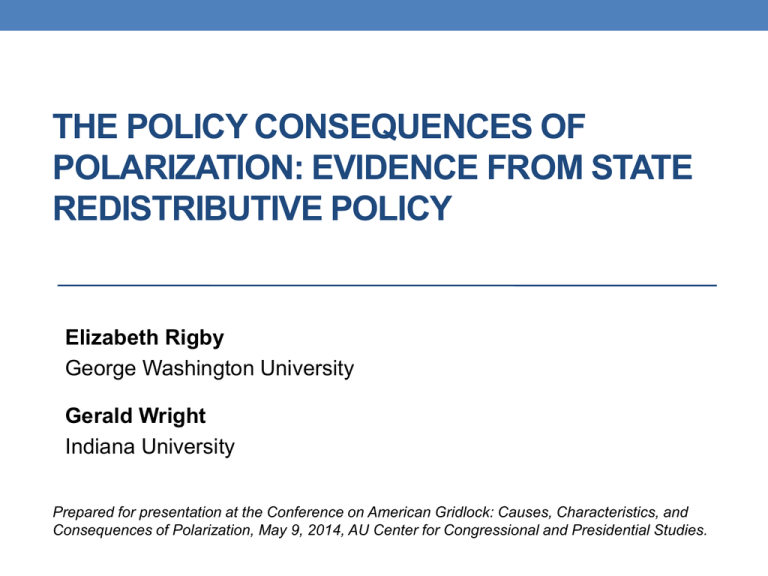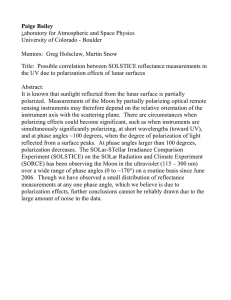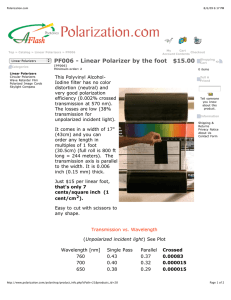THE POLICY CONSEQUENCES OF POLARIZATION: EVIDENCE FROM STATE REDISTRIBUTIVE POLICY Elizabeth Rigby
advertisement

THE POLICY CONSEQUENCES OF POLARIZATION: EVIDENCE FROM STATE REDISTRIBUTIVE POLICY Elizabeth Rigby George Washington University Gerald Wright Indiana University Prepared for presentation at the Conference on American Gridlock: Causes, Characteristics, and Consequences of Polarization, May 9, 2014, AU Center for Congressional and Presidential Studies. Co-occurring National Trends • Greater party polarization • Increased income inequality • Retrenchment of American welfare state • Accounts of these political developments often draw linkages among these trends describing how party polarization gridlock and policy drift systematic disadvantage for those with less power and organization (e.g., the poor) McCarty, Poole, & Rosenthal: Dance of Inequality • Correlated trend in declining minimum wage & estate/income taxes • “[Evidence] does seem to point strongly in the direction of a conservative effect of polarization on social policy.” (McCarty 2007, p. 243) Both logics may apply • Polarization may lead to gridlock and blocking that impedes policy change AND • Polarization may increase the likelihood that at least one party represents the poor • Further elaboration of the policy consequences of polarization are needed • Yet, these efforts are hindered by the near-exclusive focus on Congressional politics and the correlated national trends • States provide another vantage point for assessing the policy consequences of party polarization Case Study: State Redistributive Policy • Long-standing laboratory for research on American politics and policy (Gray 2010) • Increasing importance of income in shaping mass partisanship and vote choice (Stonecash, Brewer, and Mariani 2003; Stonecash 2000) • Largest income gap in policy preferences on redistributive policy issues (Gilens 2009; Rigby and Wright 2010) Contradicts earlier thinking regarding the role of parties in representation of the poor • Conventional wisdom that strong and competitive parties with defined issue bases would promote representation of less powerful citizens (Key 1949; Schattschneider 1942; APSA 1950) • Supported by other work findings class-based polarization in the states to lead to more generous welfare benefits (Brown 1995; Dye 1984; Garand 1985; Jennings 1979) Liberalism: Economic Redistribution LowIncome MiddleIncome HighIncome -.5 0 Note: State means for policy preference of each income group. Source data from 2000 Annenberg Election Survey. .5 Liberalism: Social Issues LowIncome MiddleIncome HighIncome -.5 0 Note: State means for policy preference of each income group. Source data from 2000 Annenberg Election Survey. .5 Polarization & Partisan Politics • We argue that understanding the policy consequences of polarization requires focusing more directly on partisan dynamics • Wish to tease apart three separate constructs: • Party polarization (distance between party means) • Legislative ideology (positioning of party system) • Party control (united, divided; or party strength) Illustration of Alternative Party Systems Congress State A _____D_______ ______________R___ __D ____R___ State B __D ____R___ State C _D________________R___ State D __D__________________ _______ R___ Illustration of Alternative Party Systems Congress State A _____D_______ ______________R___ __D ____R___ State B __D ____R___ State C _D________________R___ State D __D__________________ ____ _R___ Expectation: Polarization & Policy • Do not expect polarization to have a direct effect on policy • No consistent liberal or conservative effect in more polarized states • But, expect polarization to matter along-side (and in combination with) other aspects of state party systems • In particular: • Legislative ideology • Patterns of party control Parties’ Policy Liberalism • Used Project Vote Smart’s NPAT data • 225 different surveys administered to candidates for state legislature, governor and Congress • N = 18,467; D & R candidates between 1996-2005 • Select 87 frequently asked policy questions • MICE to impute missing data across 87 items • Estimated policy liberalism for 98 state parties • Democrats & Republicans in 49 states, exclude NE • Weight cases for non-response (inverse of pr(P)) • Calculated • Party polarization (distance between D & R liberalism) • Legislative ideology (weighted mean of D & R liberalism) Estimates of State Party Polarization, Pooled 1996–2006 Lo w P arty Po l ar izati on RI LA MS AR NJ DE KY WV ND AL CT HI NV KS SD WY 0 .8 68 0 .9 59 0 .9 63 0 .9 64 0 .9 81 0 .9 93 1 .0 68 1 .0 76 1 .1 03 1 .1 18 1 .1 45 1 .1 61 1 .1 64 1 .1 72 1 .1 84 1 .1 94 M o der at e Po lar izatio n PA IN VT TN IL VA NY FL MD MD OH OK ME IA ID UT SC 1 .24 8 1 .25 1 1 .26 6 1 .26 7 1 .31 2 1 .31 6 1 .34 9 1 .36 6 1 .36 7 1 .36 7 1 .41 0 1 .41 8 1 .44 6 1 .45 2 1 .47 9 1 .48 9 1 .49 4 H ig h Part y P o lari zat io n MA NH OR GA MI MO NC MT AK WI NM MN AZ WA CO TX CA 1 .5 1 8 1 .5 3 7 1 .5 4 0 1 .5 4 2 1 .5 4 8 1 .5 5 3 1 .5 5 3 1 .6 0 5 1 .6 5 7 1 .6 7 3 1 .7 1 6 1 .7 9 2 1 .8 4 8 1 .8 8 1 1 .9 1 7 2 .0 1 9 2 .1 3 1 Party Polarization >1.5 1.37 to 1.55 1.16, to 1.37 <1.16 1 Polarization in the Context of the Party System .5 MA HI CT RI NY MD NJ DE WV FL 0 AL LA AR KYND CA IL VT VA NV KS WY SD ME IA PA TN IN SC OH OK NM NC NH OR MI MN WA AZ MO GA UT WI TX MT AK CO -.5 MS ID 1 1.5 Party Polarization 2 Analytic Strategy • Estimate random-effect models • N=588, i=49, t=12 (1997-2008) • Standard errors clustered for 49 states • Year fixed-effects • Control for initial policy level (1996) and a range of state context variables (economic, political, demographic) • Estimate models for 8 redistributive policies * TANF eligibility * SCHIP eligibility * Minimum wage * Tax credit at 100% FPL * Taxes at 500% FPL * Top marginal tax rate * Capital gains tax rate * Corporate tax rate Redistributive Policies M sd Min Max TANF Eligibility 891.78 344.03 269.91 1895.14 SCHIP Eligibliity 219.95 52.27 114.28 430.76 6.55 0.99 2.03 8.69 51.34 419.05 -613.39 1831.91 Tax Charge (500%) 3371.11 1843.21 0.00 6950.38 Top Marg Tax Rate 5.12 2.92 0.00 10.75 Cap Gains Tax 4.81 2.86 0.00 10.75 Corporate Tax 6.61 2.87 0.00 12.00 Redistributive Policy Minimum Wage Tax Credit (100%) Independent Variables M sd Min Max 1.39 0.29 0.87 2.13 Legislative Ideology -0.01 0.28 -0.65 0.83 Dem Party Control 1.49 1.08 0.00 3.00 Ideology -0.14 0.08 -0.30 0.04 Per Capita Income 35.88 5.70 24.29 57.09 Unemployment 4.71 1.13 2.30 8.40 Income Inequality 0.40 0.02 0.36 0.46 % Latino 8.85 9.45 0.80 43.30 10.45 9.66 0.40 36.80 Income Vote Bias 1.66 0.28 1.15 2.89 Legislative Prof. 2.84 1.08 1.00 5.00 State Party Systems Party Polarization State Context Variables % African American Bivariate Associations Polarization (1) Ideology (2) Dem Control (3) (1) Party Polarization 1.00 (2) Legislative Ideology -0.10 * 1.00 (3) Dem Party Control -0.11 * 0.45 * 1.00 (4) TANF Eligibility 0.12 * 0.15 * 0.02 (5) SCHIP Eligibliity 0.33 * 0.36 * (6) Minimum Wage 0.10 * 0.40 * 0.29 * (7) Tax Credit (100%) 0.12 * 0.32 * 0.00 (8) Tax Charge (500%) -0.03 0.20 * 0.25 * (9) Top Marg Tax Rate -0.02 0.27 * 0.24 * -0.01 (10) Cap Gains Tax 0.00 0.25 * 0.24 * (11) Corporate Tax -0.09 * 0.36 * 0.17 * Polarization & Policy Change Party Polarization (1) TANF (2) SCHIP -15.49 (118.19) 13.19 (14.25) (3) (4) (5) Minimum Tax Credit Tax Charge 0.20 (0.27) -160.64 (85.44) -27.04 (154.60) (6) Top (7) Cap -0.07 (0.22) -0.18 (0.46) (8) Corporate 0.44 (0.39) Note: N=588, i=49, t=12; Coefficients from random-effects models which control for the initial1996 policy, year fixed effects, and the full range of state characteristics. Polarization & Policy Change (cont.) SCHIP Min Wage Tax Credit Tax 500% -27.61 (121.59) 17.92 (14.97) 0.23 (0.28) -143.61 (90.66) -11.99 (161.79) -45.59 (93.80) -4.10 (19.15) -24.54 (226.20) 3.89 (36.59) TANF Party Polarization Leg Ideology Pol * Leg Ideology Top Tax Rate Cap Gains Corporate Tax Tax 0.06 (0.24) 0.45 (0.45) 0.39 (0.40) 2.61 * 1343.21 * 21.62 (1.08) (323.05) (481.91) 2.47 * (0.90) 5.77 * (0.65) 1.35 (0.62) -2.01 * -978.05 * 36.01 (0.70) (209.30) (308.06) -1.55 * (0.58) -2.39 * (1.16) -1.31 (1.06) Note: N=588, i=49, t=12; Coefficients from random-effects models which control for the initial1996 policy, year fixed effects, and the full range of state characteristics. Change in State Top Marginal Tax Rates Change in State Minimum Wage Role of Party Control (1) TANF Eligibility (2) SCHIP Eligibility (3) Minimum Wage (4) (5) (6) (7) (8) Tax Credit Tax Charge Top Marg Cap Gains Corporate (100%) (500%) Tax Rate Tax Tax Dem Party Control -16.89 (37.05) Party Polarization -38.60 (132.12) 29.91 (17.37) 0.02 (0.35) -51.34 (105.55) Legislative Ideology -131.65 (100.86) -11.33 (18.71) -0.84 * (0.38) -205.42 (105.99) Polarization * Dem Contol 6.07 (26.45) -8.84 (5.46) 0.04 (0.11) Leg Ideo * Dem Control 62.86 * (29.82) 16.60 * (6.02) 0.29 * (0.12) 17.07 * (7.72) 0.04 (0.15) 125.03 * (42.51) 251.50 * (53.17) 0.74 * (0.12) 1.02 * (0.26) 0.25 (0.25) 310.65 (174.79) 0.81 * (0.28) 1.63 * (0.56) 0.56 (0.51) 183.33 (140.38) -0.12 (0.30) 1.56 * (0.62) -0.99 (0.60) -80.96 * (30.14) -171.93 * (37.82) -0.48 * (0.09) -0.76 * (0.18) -0.15 (0.18) 106.32 * (33.21) 41.99 (41.33) 0.46 * (0.09) 0.82 * (0.20) 0.34 (0.20) Note: N=588, i=49, t=12; Coefficients from random-effects models which control for the initial1996 policy, year fixed effects, and the full range of state characteristics. Polarization * Party Control 4.5 5 5.5 6 Predicted Top Marginal Tax, by Party Control & Polarization 4 7.5 Predicted Minimum Wage, by Party Control & Polarization Republican Control 1.9 2.1 7 1.7 Democratic Control 6.5 1.5 Polarization 6 1.3 5.5 1.1 Linear Prediction .9 .9 1.1 1.3 1.5 1.7 Party Polarization Republican Control 1.9 Democratic Control 2.1 Legislative Ideology * Party Control 4.5 5 5.5 6 6.5 Predicted Tax Rate, by Party Control & Legislative Ideology 4 7.5 Predicted Minimum Wage, by Party Control & Legislative Ideology .6 .7 .8 Democratic Control 6.5 Republican Control .5 7 .4 .3 .2 .1 0 -.2 -.1 Legislative Ideology (Liberalism) 6 -.3 5.5 -.4 5 -.5 Linear Prediction -.6 -.6 -.5 -.4 -.3 -.2 -.1 0 .1 .2 .3 Legislative Ideology Republican Control .4 .5 .6 Democratic Control .7 .8 Key Findings • No evidence of polarization directly impacting redistributive policy outcomes (in either liberal or conservative direction) • Instead, polarization mutes the policy consequences of party system liberalism and of party control (likely through gridlock and minority party opposition) • Further, liberalism of the state parties is more consistently related to redistributive policy expansion or retrenchment than is polarization • Conclude that polarization is only one of many characteristics of party systems that shape the policymaking process.






